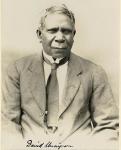David Unaipon was born at the Point McLeay Mission, South Australia, and attended the mission school until 1885 when he left to become a servant. Encouraged by others to pursue his interest in philosophy, science and music, Unaipon read widely and became well-known for his intellectual capacity and inventions. He spoke regularly at schools and learned societies, and often attended government enquiries.
In the 1920s, he began to study western mythology and began collecting his own people's myths and legends. He wrote for the Sydney Daily Telegraph newspaper from 1924, and began publishing compilations of his myths. He is considered to be the first Indigenous Australian author, publishing Aboriginal legends in the 1920s. Without permission, the publisher Angus and Robertson sold the copyright of the stories to William Ramsay Smith who published Myths and Legends of the Australian Aboriginals (1930) without acknowledgement. W. R. Smith also published some of Unaipon's stories as Australian Legends (1984), with notes in Japanese.
Remaining a prominent voice in Aboriginal affairs, Unaipon continued to advise the state and Commonwealth, appearing before several royal commissions into the treatment of Aborigines.
David Unaipon received a Coronation medal in 1953. He continued to travel and speak widely and, late in life, returned to his inventions, seeking the key to perpetual motion. He died in 1967. In the 1990s, Unaipon's manuscript of Aboriginal legends was edited and published as Legendary Tales of the Australian Aborigines (2001), adopting his original title and finally acknowledging his authorship.
An annual award, The David Unaipon Literary Award, for an unpublished manuscript by and Aboriginal or Torres Strait Islander writer honours him. He is also depicted on the Australian $50 note.
David Unaipon was chosen as one of 150 great South Australians by a panel of The Advertiser senior writers to celebrate the 150th Anniversay of The Advertiser newspaper, 12 April 2008.

